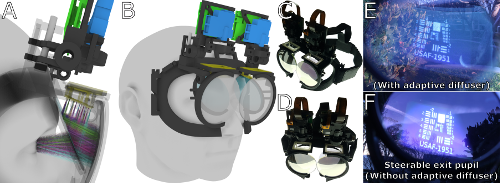Steerable application-adaptive near eye displays

The design challenges of see-through near-eye displays can be mitigated by specializing an augmented reality device for a particular application. We present a novel optical design for augmented reality near-eye displays exploiting 3D stereolithography printing techniques to achieve similar characteristics to progressive prescription binoculars. We propose to manufacture inter-changeable optical components using 3D printing, leading to arbitrary shaped static projection screen surfaces that are adaptive to the targeted applications. We identify a computational optical design methodology to generate various optical components accordingly, leading to small compute and power demands. To this end, we introduce our augmented reality prototype with a moderate form-factor, large field of view. We have also presented that our prototype is promising high resolutions for a foveation technique using a moving lens in front of a projection system. We believe our display technique provides a gate-way to application-adaptive, easily replicable, customizable, and cost-effective near-eye display designs.
Publication Date
Research Area
External Links
Copyright
Copyright by the Association for Computing Machinery, Inc. Permission to make digital or hard copies of part or all of this work for personal or classroom use is granted without fee provided that copies are not made or distributed for profit or commercial advantage and that copies bear this notice and the full citation on the first page. Copyrights for components of this work owned by others than ACM must be honored. Abstracting with credit is permitted. To copy otherwise, to republish, to post on servers, or to redistribute to lists, requires prior specific permission and/or a fee. Request permissions from Publications Dept, ACM Inc., fax +1 (212) 869-0481, or permissions@acm.org. The definitive version of this paper can be found at ACM's Digital Library http://www.acm.org/dl/.
